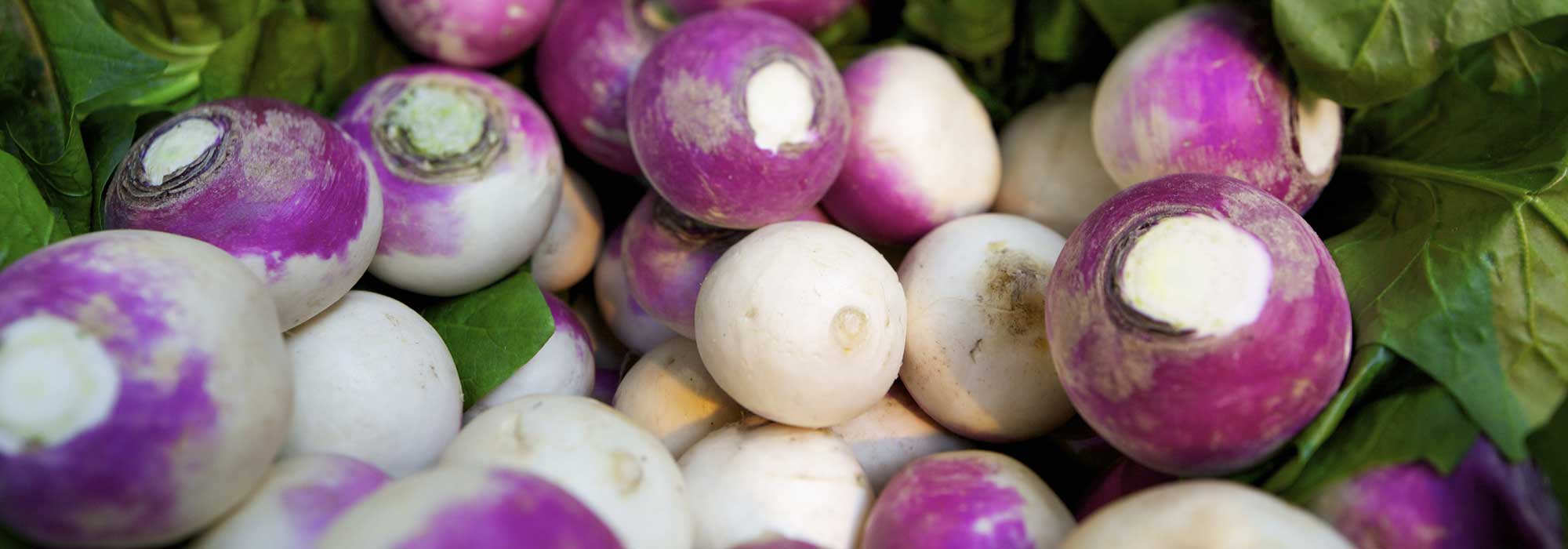
Turnip: sowing, growing and care
Contents
Turnip in a nutshell
- Turnip is a root vegetable from the Brassicaceae family, like radish, cabbage, mustard, and rocket.
- It prefers light, consistently moist, rich soil that is free from lime, as well as exposure to sun or partial shade depending on the growing season.
- It is possible to sow turnip seeds from February to the end of August to have harvests for a good part of the year, usually two months after sowing.
- Some pests like cabbage fly and flea beetles can be problematic, but measures can be taken to prevent their damage.
- Turnips can be harvested as needed, and winter turnips can be stored in a silo or cellar.
A word from our expert
In the West, turnip has never been highly regarded; for a long time, it was considered a famine food and was mainly consumed by the poorest classes of society. It was widely used as a fodder plant.
Today, it remains a relatively under-consumed vegetable, and for gardeners, although its cultivation is quick, it presents various challenges with pests from the cabbage family, such as flea beetles and cabbage flies. This is unfortunate because it is quite easy to protect against their damage… and the flavour of turnips is well worth the effort you put into growing them! It is worth noting that spring turnips have a finer taste, and by choosing a variety like ‘Noir long de Pez’, you will discover a sweeter flavour than most other varieties.
In the vegetable garden, for sowing, this saying is often remembered:
“He who wants good turnips sows them in July”
However, in reality, turnips are sown from mid-February to the end of August.
Turnips thrive in any cool, rich, loose, and well-drained soil. They do not like overly chalky ground. While they enjoy sunlight in spring and late autumn, they prefer partial shade in summer. Mild and humid climates suit them perfectly.
Let us conclude this introduction with a bit of poetry, featuring this Japanese Haiku by Kobayashi Issa:
The turnip puller
Shows the way
With a turnip
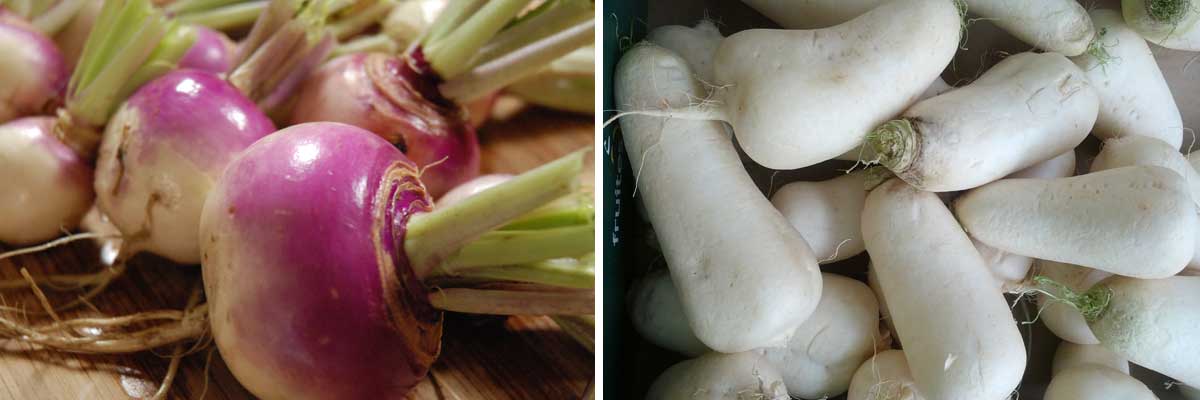
Early type turnips – Vertus des Marteau turnips
Description and Botany
Botanical data
- Latin name Brassica rapa subsp. rapa
- Family Brassicaceae
- Common name Turnip
- Flowering Annual
- Height 5 years and more
- Sun exposure Sun and partial shade
- Soil type Rich, well-drained, cool
- Hardiness Good hardiness (-5°C)
The turnip is believed to originate from an area extending from the eastern and central Mediterranean basin. However, tracing its history is challenging due to the often confusing and contradictory taxonomy, particularly regarding descriptions. From the Mediterranean, the turnip migrated to Northern Europe. There are, however, writings dating back to Pliny (early Christian era) mentioning six varieties, and Olivier de Serres (17th century) provided a well-developed description. The term “turnip” appeared in the 13th century, derived from the fact that there has been a significant effort in selections over the last two centuries.
The turnip, Brassica rapa subsp. rapa, is a biennial herbaceous plant cultivated as an annual. It is a root vegetable grown for its fleshy root. In the first year, the turnip forms a rosette of oblong, lyrate leaves, a bright green, covered with stiff hairs. It develops a main root (the turnip) and a secondary root located beneath the main one.
Depending on the selections, the root will develop different shapes, epidermis colours, flesh colours, flavours, and textures. Regarding shape, the root varies from spherical, more or less flattened, to elongated cylindrical like a carrot or swollen at the lower part like the variety ‘Des Vertus Marteau’. Its colour, for the spherical type, ranges from yellow, white, or purple, often bicoloured, purple at the neck and white at the secondary root. For the cylindrical types, black or white colours are predominantly found. It is also worth noting that young turnips have a fairly firm texture, which becomes hollow at the end of the growing cycle. During dry periods, the area just beneath the epidermis becomes fibrous, which partly explains its superior taste in off-season cultivation.
If it withstands winter cold, the turnip produces a flowering stem in the second year of cultivation. This stem is smooth and measures about 80 cm tall, flowering in spring. It bears flowers with petals arranged in a cross, which is a characteristic of the Brassicaceae family. Notably, the old name for the family – Cruciferae – highlighted this characteristic, as cruci = cross. The flowers develop into long, thin siliques, containing between 15 and 25 small seeds, brick red to black.
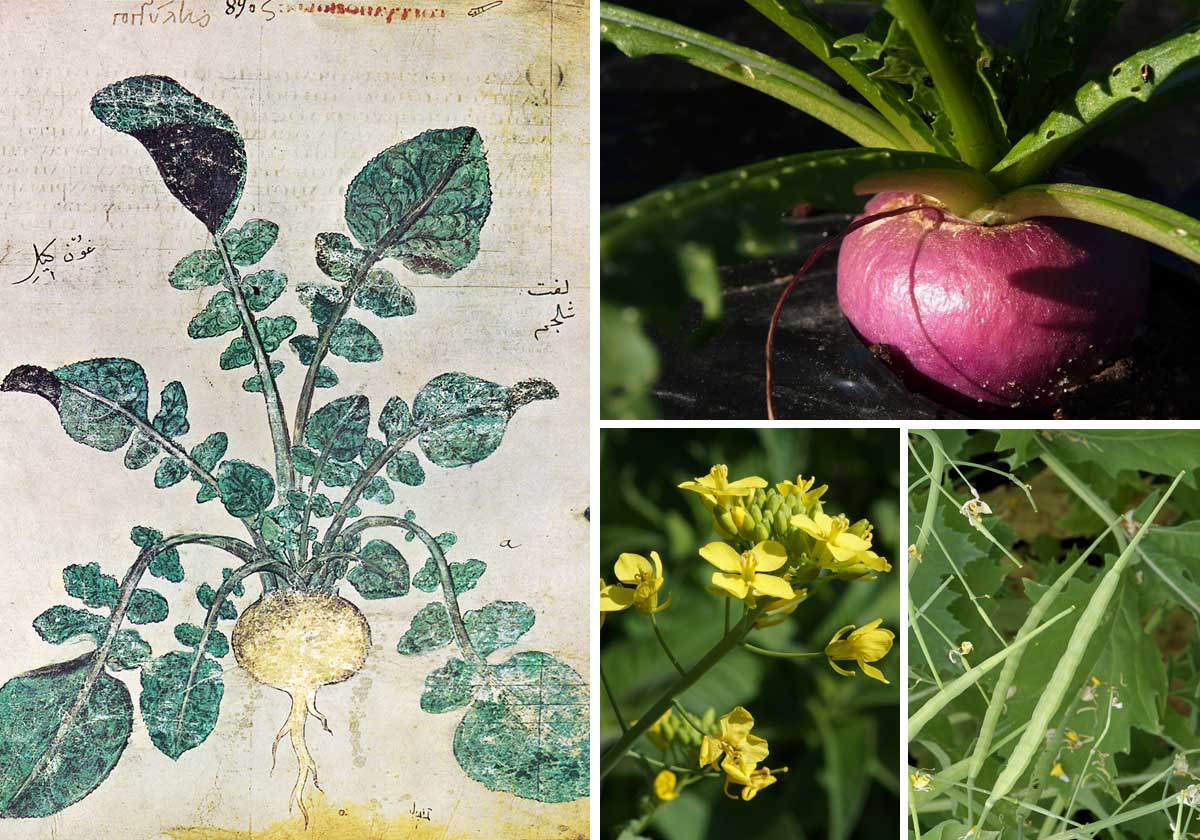
Botanical illustration of the turnip – A turnip in cultivation – Flowers and siliques
Turnip varieties
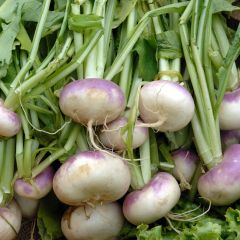
Turnip Early Flat Red - Vilmorin Seeds
- Flowering time July to October
- Height at maturity 30 cm
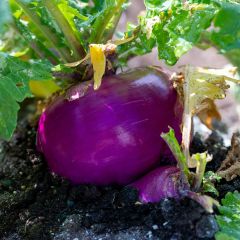
Turnip Milan Rouge - Brassica rapa
- Height at maturity 30 cm
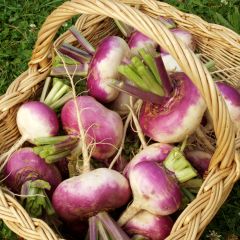
Turnip Early Auvergne - Vilmorin Seeds
- Flowering time July to October
- Height at maturity 30 cm
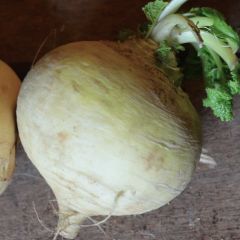
Turnip Giant Limousin
- Flowering time July to October
- Height at maturity 30 cm
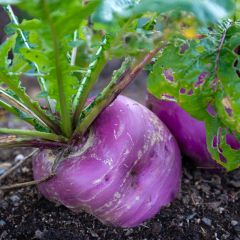
Turnip Plessis F1 - Vilmorin Seeds
- Flowering time July to October
- Height at maturity 30 cm
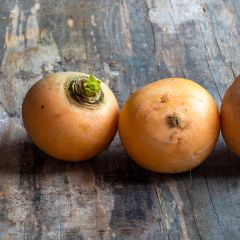
Turnip Golden Ball - Ferme de Sainte Marthe Seeds
- Height at maturity 30 cm
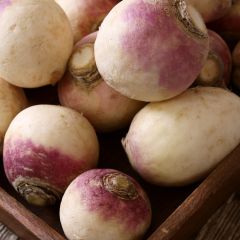
Turnip De Péronne
- Flowering time July to October
- Height at maturity 30 cm
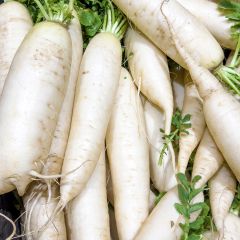
Turnip De Croissy - Vilmorin Seeds
- Flowering time July to October
- Height at maturity 30 cm
Discover other Turnip seeds
View all →Available in 1 sizes
Available in 1 sizes
Available in 1 sizes
Available in 1 sizes
Available in 1 sizes
Available in 1 sizes
Available in 1 sizes
Available in 1 sizes
Available in 1 sizes
Available in 1 sizes
Sow the turnip
Where and when to sow turnips?
Turnips can be sown throughout mainland France, they prefer light, cool, rich soils that are free of lime. They are sensitive to frost, drought, and very sunny exposures in summer.
Turnips have the advantage of being sown almost all year round: Spring turnips can be sown as early as February in forced cultivation and until April outdoors.
Summer turnips are sown in May, June, and July, while autumn and winter turnips are sown in summer during July and August. Each variety corresponds to an ideal sowing period that should be respected, but generally, sowing occurs:
- from mid-February to the end of March (under cover), for a harvest in early spring
For example: ‘Milan to force with pink collar’, ‘Early Auvergne’, ‘Snowball White’ - from the end of March to the end of April, for a harvest in late spring – early summer
For example: ‘Early flat red with whole leaves’, ‘Croissy’ - from May to July, for a harvest in late summer,
For example: ‘White Globe with purple collar’, ‘Vertus Marteau’ - from mid-July to the end of August, for an autumn and winter harvest,
For example: ‘Yellow Globe of Gold’, ‘Late Auvergne’, ‘Plessis F1’, ‘Long Black’
In a mild microclimate, it is possible to reseed as early as November. Sowing turnips is done directly in place, in well-prepared soil: the ground is weeded, loosened with a grelinette, levelled with a rake, and then raked to obtain fine soil.
How to sow turnips?
Turnips are sown sparsely (the seeds should be well spaced), at a depth of one centimetre in rows spaced 20 to 30 cm apart. As turnips are a root vegetable with small seeds, the soil must be carefully loosened and flattened before sowing.
To sow your turnip seeds:
- Draw furrows 1 cm deep with the handle of a tool, for example.
- Sow sparsely, placing one seed every 5 cm.
- Cover the seeds with a little fine soil.
- Lightly firm with the back of the rake.
- Keep the soil moist to ensure quick germination.
As soon as the turnips have at least two leaves, thin out by keeping one plant every 10 to 12 cm. Do not replant the seedlings removed during thinning, as they do not appreciate being transplanted.
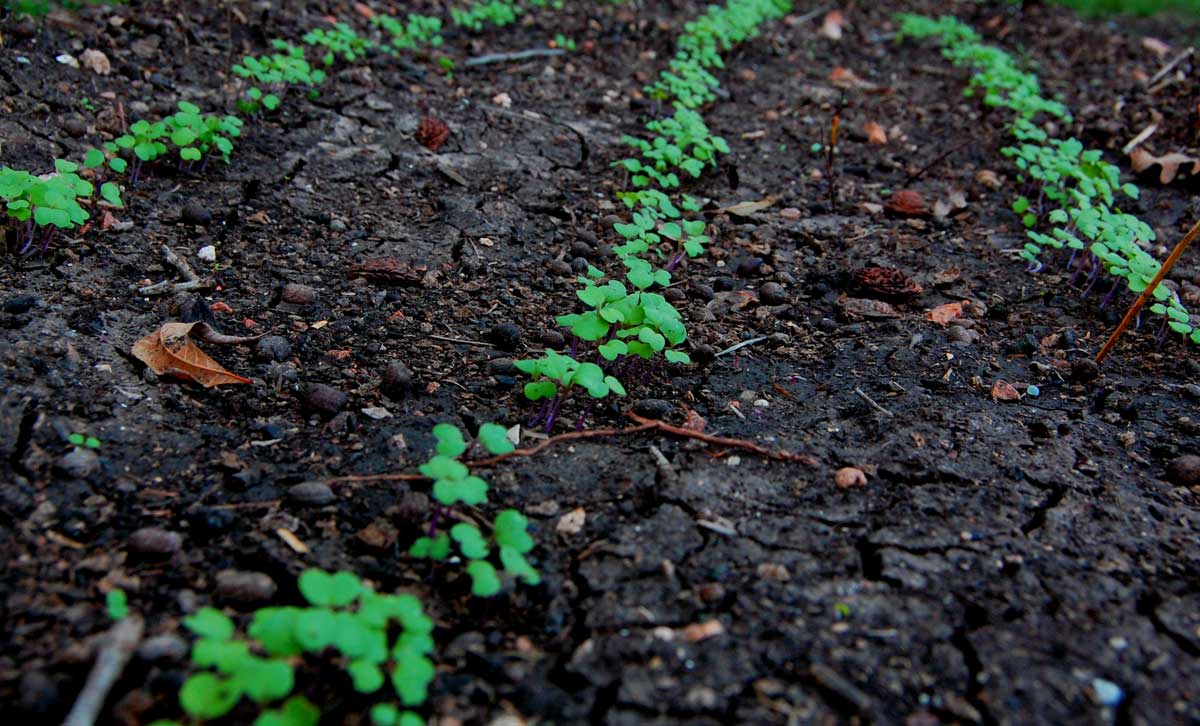
Germination of turnip seedlings
Growing, care and association
Regular maintenance involves carrying out weeding, hoeing, and watering, as regularly as possible. These operations can be spaced out or significantly reduced if you mulch the soil with fine successive layers of dried grass clippings or dead leaves, for example.
The secret to successfully growing turnips lies in watering; it must be as regular as possible!
Regarding companion planting, turnips pair well with fennel, peas, beans, carrots, chicories, and lettuce. However, avoid planting them near vegetables from the same family, such as cabbages and radishes. Planting fennel next to turnips helps to repel flea beetles and turnip flies. If necessary, for better protection, use a cloche or insect netting. Carry out regular weeding and hoeing.
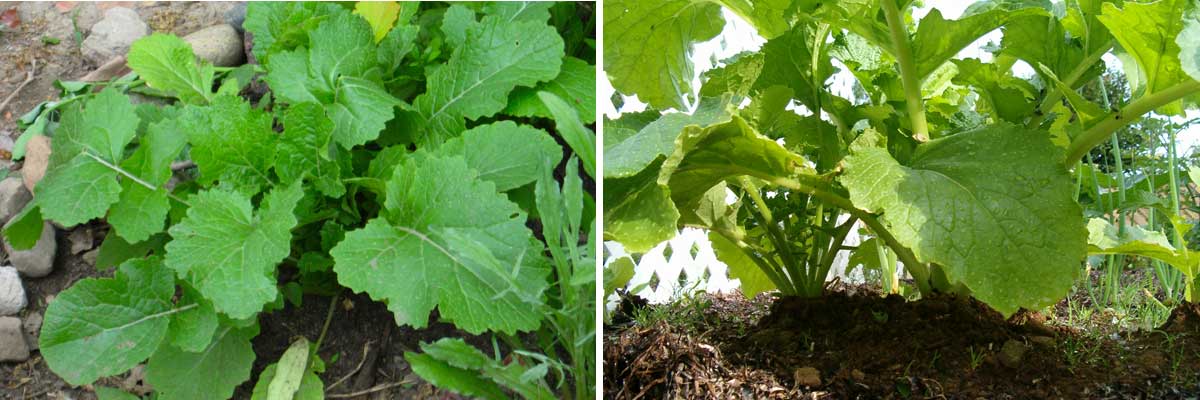
turnips in cultivation
In terms of crop rotation, avoid growing turnips in the same plot for 3 to 4 years.
Diseases and pests of turnip
Turnip generally grows without issues. However, during its cultivation, you may encounter:
- the turnip fly whose larvae devour the roots,
- flea beetles that perforate the leaves of brassicas in general,
- slugs and snails that attack young plants.
The Cabbage Fly
The cabbage fly Delia radicum is a common pest of turnip whose larvae devour the roots, leaving galleries accompanied by rot. This pest is particularly problematic in spring, from late March to May and then in September, which coincides with the peak growth periods of turnip!
As a preventive measure, it is possible to sow early in the year and alternate rows of fennel and turnips. But the best prevention is to place an insect-proof netting securely.
The Flea Beetles
Have your turnips survived the cabbage fly? Now you need to avoid the flea beetle! This insect arrives later than the fly, when it is hot and dry in summer. Flea beetles (Phyllotreta nemorum, Psylliodes chrysocephala) are small jumping beetles that will perforate the foliage of turnips, causing a significant slowdown in growth or even the death of young seedlings.
As a preventive measure, it is essential to water regularly, as they do not appreciate humidity. The best prevention here too is to place an insect-proof netting securely.
Slugs and Snails
Slugs and snails are a potential concern, especially during winter and spring sowings. Check Ingrid’s article on natural control of slugs.
→ Learn more about the diseases and pests of turnip in our advice sheet.

Turnip Fly – Cabbage fly larva (right) and pupa (left) – Cabbage flea beetle (Photograph by Christophe Quintin)
Harvest and storage
Turnips are generally harvested two months after sowing. Spring-summer turnips will be harvested according to needs and desired size, from May to July. Autumn-winter varieties, intended for storage, will be pulled from October and before the first frosts. To harvest them, lift with a fork and gently pull at the base of the leaves.
Do not wait too long before harvesting your turnips; it is better for them to be small to medium-sized rather than too large, as the latter are often stringy, which is never pleasant in the mouth.
After harvesting, let the turnips dry for a few hours on the soil, then cut the foliage above the collar. Turnips can be stored for several months in a silo or cellar, in dry sand, in a cool and dark place.
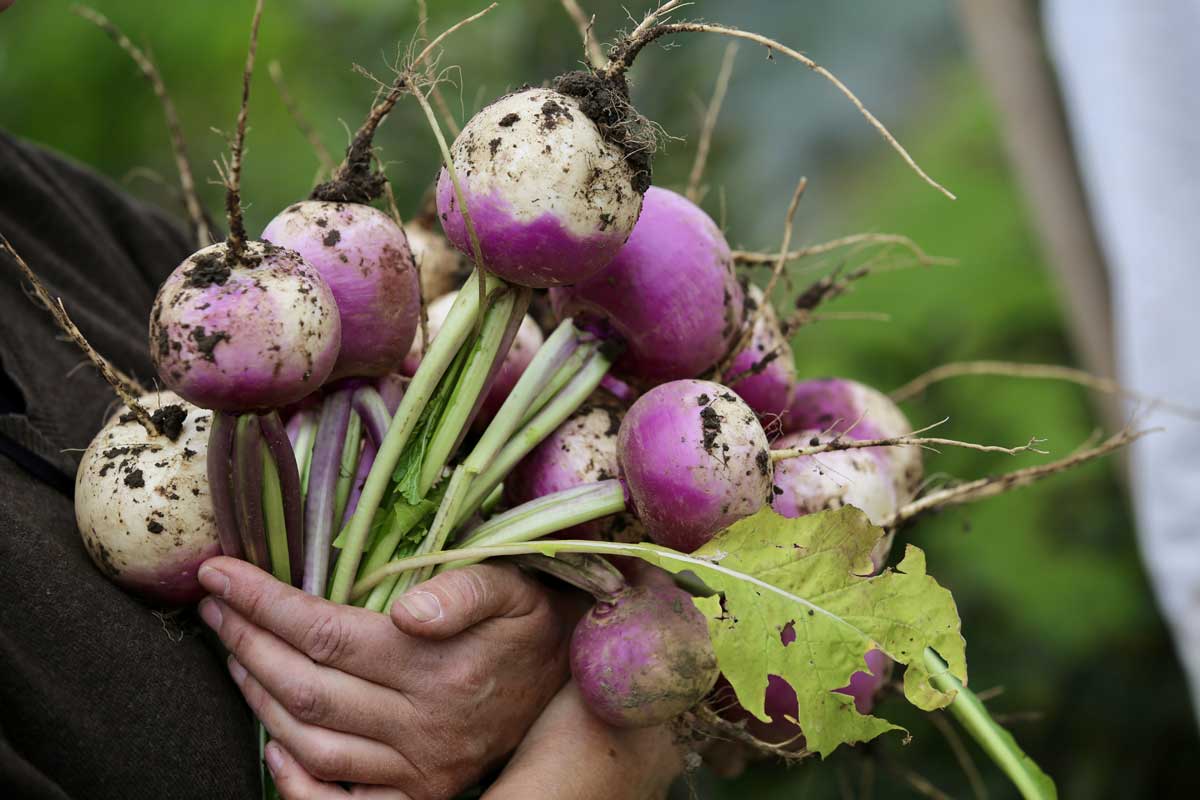
Harvesting early turnips
→ Also discover Ingrid’s tips on lacto-fermentation
Uses and nutritional benefits
Spring turnip has a finer taste than autumn and winter turnip, which is generally much stronger. It can be eaten raw or cooked, but is more often cooked, for example in a gratin, tart, purée, or as an accompaniment to soup, stew, and casserole; it is also excellent when candied with honey! For boiling, it takes between 10 to 15 minutes, or 7 to 10 minutes in a pressure cooker, depending on the size of the turnips. It pairs well with other root vegetables such as carrots, beetroots, potatoes, as well as leeks.Young turnips do not need to be peeled and can be eaten raw, grated and mixed with other raw vegetables. The young turnip leaves can also be used in soups.
Turnip is a relatively low-calorie vegetable, containing fibre, carbohydrates, proteins, vitamins, and minerals. It has diuretic, refreshing, and remineralising properties. Turnip is a good source of vitamin C when consumed raw! It also contains vitamins A, B5, B6, PP, and minerals and trace elements (calcium, iron, copper, magnesium).
Useful resources
Discover in our online shop our wide range of turnip seeds.
Advice sheet: Forage plants, 5 vegetables for animals
Our advice sheets: How to choose turnips? and Growing spring turnips
Frequently asked questions
-
Does the turnip freeze?
Turnips can withstand temperatures of around -5°C; below this, they are damaged. If you are in a region with mild winters, they can be left in the ground if covered with a layer of leaves or straw. In a more continental climate, it is better to lift them and store them in a clamp or cellar.
-
My turnips aren't growing, why?
Proper watering is essential for successfully growing turnips; it should be as regular as possible. Once the young plants have suffered from a lack of water, it becomes difficult to recover the crop.
-
Why do my turnips have holey leaves?
It is most likely flea beetles, those "soil fleas". It is not very serious when the turnips are already well developed, but it is more concerning at the seedling stage where the seedlings can easily wither. Watering regularly and gently should prevent this flea beetle problem, but if their presence is too overwhelming, it is necessary to place an insect net from the time of sowing.
- Subscribe!
- Contents
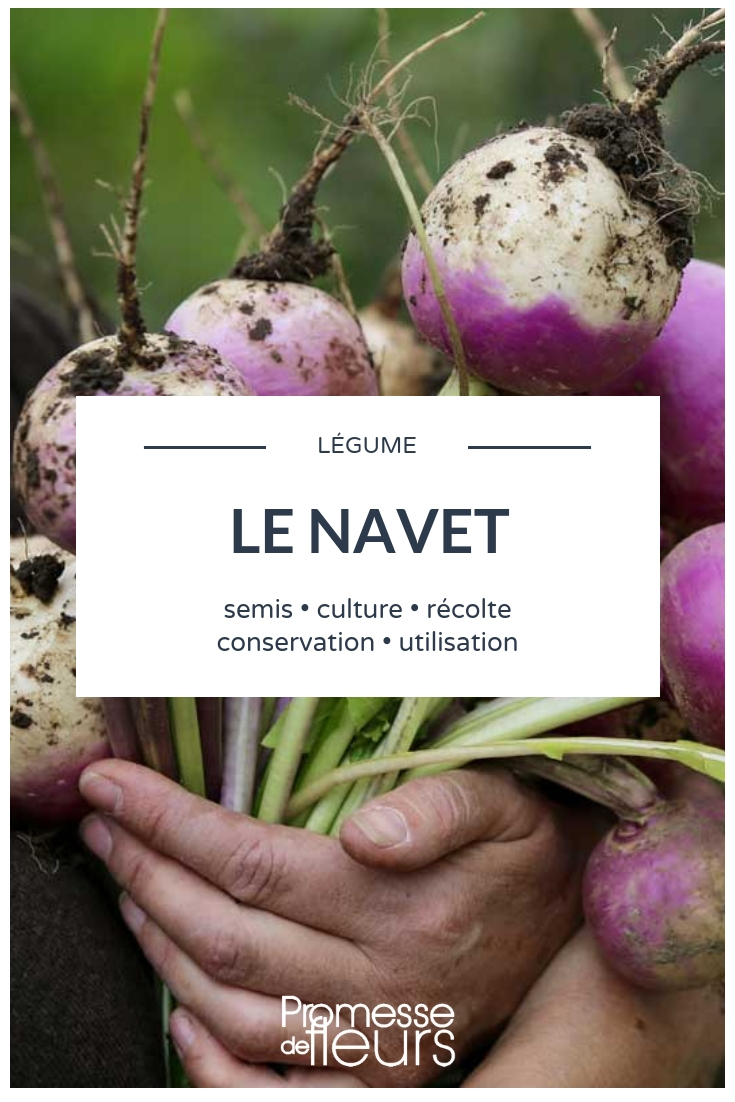































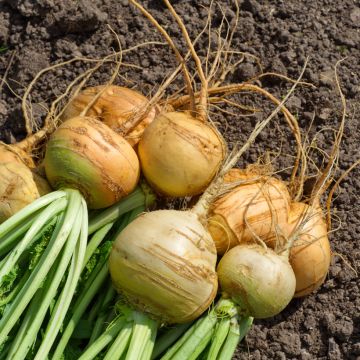

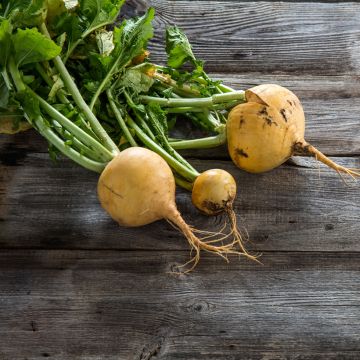
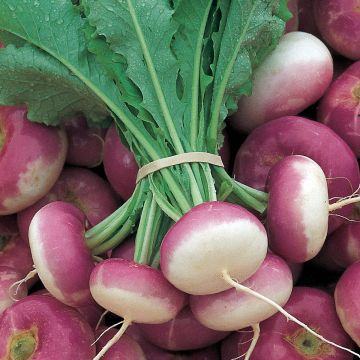
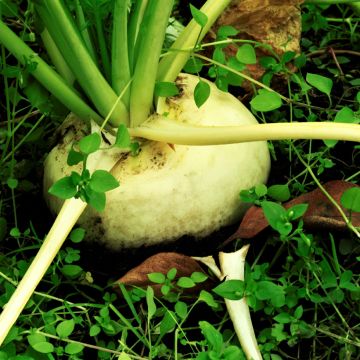



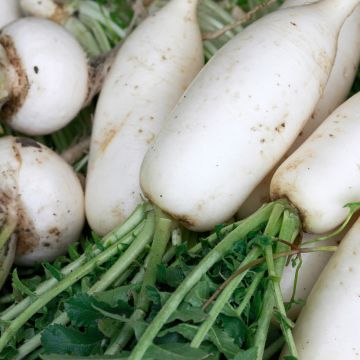
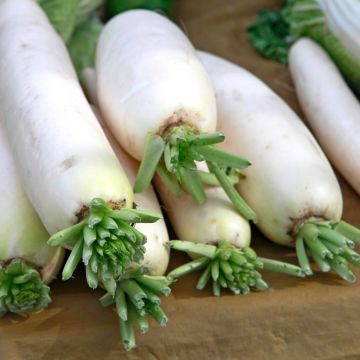
Comments